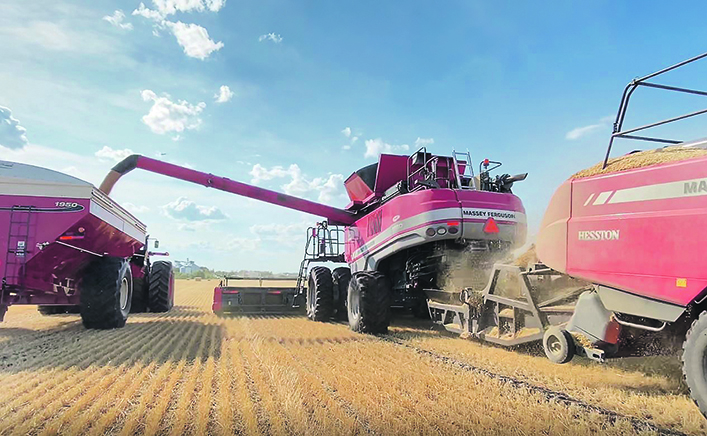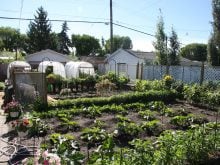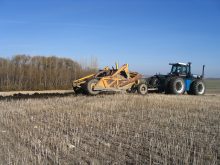The idea of baling residue right off the combine is at least 30 years old. However, the nuisance factor along with numerous little glitches prevent prairie producers from considering it.
The practice adds two more pieces of machinery to an already harried harvest operation. While it’s old hat for Australian grain growers, their farming season is vastly different. Australian farmers have a long, relaxed harvest with only rare events of interference from wet weather.
On the other side of the world, the grain harvests are typically more hectic, beginning in July and running through to the first snowfall and later. Farmers always keep one eye on the weather app as they keep their machines running at maximum possible speeds. Slowing the combine to fiddle with extra equipment just isn’t in the cards.
The more hectic harvest has also been cited as the reason fall-seeded crops have never caught on in a big way.
Last year, Ian Thorson decided the reasons to try combine baling might outweigh the reasons to not try it. Thorson runs a grain farm along with an 87-cow herd at Kinistino Sask. He is also founder and owner of AgWorld at Kinistino.
Thorson said examples of conveyors relaying straw and chaff from the combine directly into a baler are well-documented on the web.
During a phone interview, Thorson said he learned a lot about what other people had done right and done wrong, giving him a head start at getting it right the first time.
“T.W. Enterprises at Melfort have a bright young engineer right out of school. I explained to Tyler (Spencer) what I needed and showed him other examples, and he did the design work,” said Thorson, adding that he named the tool the combine/baler/combo. The machine was ready for the 2021 harvest. Thorson said it worked flawlessly.
“As a result, I now have 1,200 wrapped straw bales. It was a dry harvest of course, so they’re at 9.1 percent moisture. Protein is 5.09 percent. ADF (acid detergent fibre) is 48.58 percent. TDN (total digestible nutrients) is 51.62 percent.
“Baling straight off the combine bumps your protein a little bit. Regular straw you bale off the ground is usually around four to 4.5 percent protein and 45 percent TDN.
“It doesn’t eliminate hay, but it’s a better quality feed than straight straw. Until now I’ve been feeding this straw along with some supplemental pellets. They’re getting about seven percent protein right now. When they get to mid-gestation and late-gestation, I’ll add some hay to bump the protein up to nine percent and eventually up around 11 percent.”
He says the combine/baler/combo concept has as much to do with agronomy in his fields as it does with the cow-calf operation. He explains there was a flaw in his cropping system. It was impossible to clean up all the straw and chaff he dropped behind his rotary combine. Even after baling, it left a row where the swath had been. Come spring, that row would plug his drill and create problems all season.
“After running the combo this year, I can see we’ve left very little reside behind. There’s standing stubble to catch snow, but nothing on the ground to plug the drill. It will have a big impact in terms of speeding up my seeding operations in the spring. We know how important that is.
“You see those chaff rows in fields all the time. They last the whole growing season. I think with chaff rows gone, I’ll get a more uniform crop, something we all want because of the obvious benefits. A crop with different growth stages will not be a top yielding crop.
“Some of the products we’re applying these days only have a four-day window. Growth regulators and fungicides and other products. So, if you have slower crops in the old chaff row, how can you do a timely spray operation? That chaff row problem carries through all the way to harvest. I expect to fix that with this combine/baler/combo.”
The other benefit is fighting herbicide-resistant weeds. Although not a major issue on his farm, Thorson says it is a problem to be reckoned with. Australian farmers are reportedly having good results in fields where residue removal straight off the combine is practiced. In university trials there, Palmer amaranth has been reduced by 37 percent to 90 percent.
“Australia is definitely ahead of us in this technology. Here, some guys are spending up to $70,000 on choppers that break the weed seed so it doesn’t germinate. This baler link will do every bit as good a job, or better, than a seed chopper.”
Canadian farmers often tune out when the conversation turns to adding further complications to harvest or slowing down their combines. It’s the main reason they have not embraced Australian technology.
Thorson says it’s not an issue for him because he has cattle, but it obviously is an issue for straight grain farmers.
“You need a cow to mentally cope with slowing down your harvest. That’s just the way it pencils out. You are adding more stops to your harvest. If the baler plugs or it doesn’t tie, you need to address it right away because you can’t turn on the chopper and spreader. They’re gone. If this slows me down at harvest, I gain a benefit in the spring when I have a cleaner field so I speed up my seeding. And that gives us a more uniform crop. A cleaner field might also help reduce herbicide applications.

“We ran a Class 8 Massey at 3.5 miles per hour with a 35-foot header. Without the combo baler tagging behind, we would have run the same speed, 3.5 miles per hour. We still do 15 acres per hour. I think you’d throw over if you went faster than 4.5 miles.
“Where it slowed us down was turning in the headlands. My design limits how sharp you can turn. I have cameras out the back to monitor the turns. Other than slower turns, stopping to fix the baler knotters was the main impediment. I’d use a cordless leaf blower a couple times a day to blow off the chaff. There’s a lot of air coming off the back of that combine. It starts swirling, and if it’s windy, it gets picked up and deposited in the baler.”
Thorson knows he has to change his fertilizer strategy. By removing residue from the field, he’s also removing nutrients to feed his cows. He has to pay to replace removed nutrients.
Although the combine/baler/combo built by TW was a prototype, Thorson says his design was based on so many other successful designs that he cannot think of any major modifications. If he decides to commercialize the machine, he figures it would go to market with a price tag of about $80,000.
“Organic is another aspect to consider. If we can get the right kind of market for organic grains, this tool will work better than some of the other weed control methods in organic farming. It removes weed seeds, bales straw and leaves the grower with a nice clean seedbed.”


















